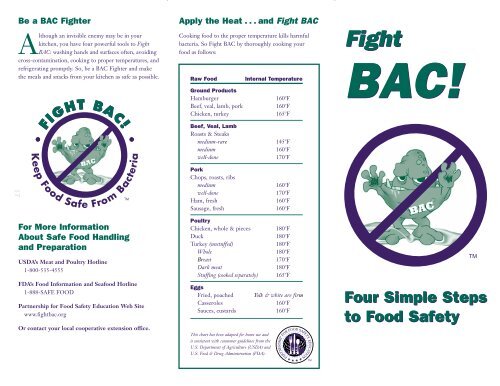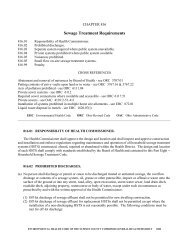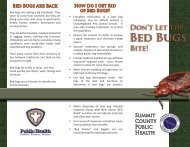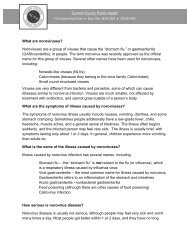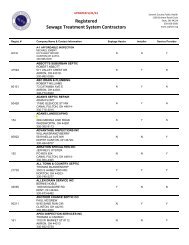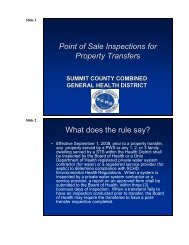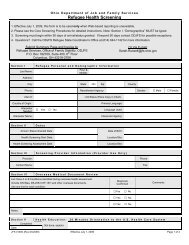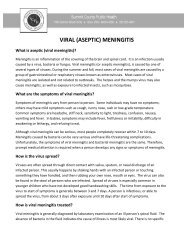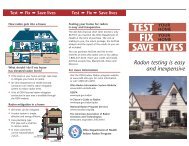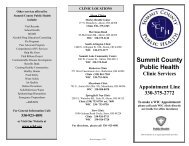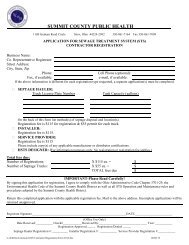Fight BAC⢠- Four Simple Steps to Food Safety Brochure
Fight BAC⢠- Four Simple Steps to Food Safety Brochure
Fight BAC⢠- Four Simple Steps to Food Safety Brochure
Create successful ePaper yourself
Turn your PDF publications into a flip-book with our unique Google optimized e-Paper software.
Be a BAC <strong>Fight</strong>er<br />
Although an invisible enemy may be in your<br />
kitchen, you have four powerful <strong>to</strong>ols <strong>to</strong> <strong>Fight</strong><br />
BAC: washing hands and surfaces often, avoiding<br />
cross-contamination, cooking <strong>to</strong> proper temperatures, and<br />
refrigerating promptly. So, be a BAC <strong>Fight</strong>er and make<br />
the meals and snacks from your kitchen as safe as possible.<br />
Apply the Heat . . . and <strong>Fight</strong> BAC<br />
Cooking food <strong>to</strong> the proper temperature kills harmful<br />
bacteria. So <strong>Fight</strong> BAC by thoroughly cooking your<br />
food as follows:<br />
Raw <strong>Food</strong><br />
Ground Products<br />
Hamburger<br />
Beef, veal, lamb, pork<br />
Chicken, turkey<br />
Internal Temperature<br />
160 o F<br />
160 o F<br />
165 o F<br />
<strong>Fight</strong><br />
BAC!<br />
Beef, Veal, Lamb<br />
Roasts & Steaks<br />
medium-rare<br />
medium<br />
well-done<br />
145 o F<br />
160 o F<br />
170 o F<br />
17<br />
Pork<br />
Chops, roasts, ribs<br />
medium<br />
well-done<br />
Ham, fresh<br />
Sausage, fresh<br />
160 o F<br />
170 o F<br />
160 o F<br />
160 o F<br />
For More Information<br />
About Safe <strong>Food</strong> Handling<br />
and Preparation<br />
USDA’s Meat and Poultry Hotline<br />
1-800-535-4555<br />
FDA’s <strong>Food</strong> Information and Seafood Hotline<br />
1-888-SAFE FOOD<br />
Partnership for <strong>Food</strong> <strong>Safety</strong> Education Web Site<br />
www.fightbac.org<br />
Or contact your local cooperative extension office.<br />
Poultry<br />
Chicken, whole & pieces<br />
Duck<br />
Turkey (unstuffed)<br />
Whole<br />
Breast<br />
Dark meat<br />
Stuffing (cooked separately)<br />
Eggs<br />
Fried, poached<br />
Casseroles<br />
Sauces, custards<br />
This chart has been adapted for home use and<br />
is consistent with consumer guidelines from the<br />
U.S. Department of Agriculture (USDA) and<br />
U.S. <strong>Food</strong> & Drug Administration (FDA).<br />
180 o F<br />
180 o F<br />
180 o F<br />
180 o F<br />
170 o F<br />
180 o F<br />
165 o F<br />
Yolk & white are firm<br />
160 o F<br />
160 o F<br />
TM<br />
<strong>Four</strong> <strong>Simple</strong> <strong>Steps</strong><br />
<strong>to</strong> <strong>Food</strong> <strong>Safety</strong><br />
TM
Right now, there may be an<br />
invisible enemy ready <strong>to</strong><br />
strike. He’s called BAC<br />
(bacteria) and he can make you and<br />
those you care about sick. In fact,<br />
even though you can’t see BAC — or<br />
smell him, or feel him — he and millions<br />
more like him may have already invaded the food you eat.<br />
But you have the power <strong>to</strong> <strong>Fight</strong> BAC and <strong>to</strong> keep your<br />
food safe from harmful bacteria. It’s as easy as following<br />
these four simple steps:<br />
Clean:<br />
Wash hands and<br />
surfaces often<br />
Bacteria can spread throughout<br />
the kitchen and get on<strong>to</strong> cutting<br />
boards, utensils, sponges and<br />
counter <strong>to</strong>ps. Here’s how <strong>to</strong> <strong>Fight</strong> BAC:<br />
18<br />
■ Wash your hands with hot soapy water before handling<br />
food and after using the bathroom, changing diapers and<br />
handling pets.<br />
■ Wash your cutting boards, dishes, utensils and counter<br />
<strong>to</strong>ps with hot soapy water after preparing each food item<br />
and before you go on <strong>to</strong> the next food.<br />
■ Use plastic or other non-porous cutting boards. These<br />
boards should be run through the dishwasher — or<br />
washed in hot soapy water — after use.<br />
■ Consider using paper <strong>to</strong>wels <strong>to</strong> clean up kitchen<br />
surfaces. If you use cloth <strong>to</strong>wels, wash them often in the<br />
hot cycle of your washing machine.<br />
Separate:<br />
Don’t crosscontaminate<br />
Cross-contamination is the scientific<br />
word for how bacteria can be spread<br />
from one food product <strong>to</strong> another.<br />
This is especially true when handling raw meat, poultry and<br />
seafood, so keep these foods and their juices away from ready<strong>to</strong>-eat<br />
foods. Here’s how <strong>to</strong> <strong>Fight</strong> BAC:<br />
■ Separate raw meat, poultry and seafood from other foods in<br />
your grocery shopping cart and in your refrigera<strong>to</strong>r.<br />
■ If possible, use a different cutting board for raw meat<br />
products.<br />
■ Always wash hands, cutting boards, dishes and utensils with<br />
hot soapy water after they come in contact with raw meat,<br />
poultry and seafood.<br />
■ Never place cooked food on a plate which previously held<br />
raw meat, poultry and seafood.<br />
Cook:<br />
Cook <strong>to</strong> proper<br />
temperatures<br />
<strong>Food</strong> safety experts agree that foods<br />
are properly cooked when they are<br />
heated for a long enough time and at a<br />
high enough temperature <strong>to</strong> kill the harmful bacteria that cause<br />
foodborne illness. The best way <strong>to</strong> <strong>Fight</strong> BAC is <strong>to</strong>:<br />
■ Use a clean thermometer, which measures the internal<br />
temperature of cooked foods, <strong>to</strong> make sure meat, poultry,<br />
casseroles and other foods are cooked all the way through.<br />
TM<br />
■ Cook ground beef, where bacteria can spread during<br />
processing, <strong>to</strong> at least 160 o F. Information from the<br />
Centers for Disease Control and Prevention (CDC) link<br />
eating undercooked, pink ground beef with a higher risk<br />
of illness. If a thermometer is not available, do not eat<br />
ground beef that is still pink inside.<br />
■ Cook eggs until the yolk and white are firm. Don’t use<br />
recipes in which eggs remain raw or only partially cooked.<br />
■ Fish should be opaque and flake easily with a fork.<br />
■ When cooking in a microwave oven, make sure there<br />
are no cold spots in food where bacteria can survive . For<br />
best results, cover food, stir and rotate for even cooking.<br />
If there is no turntable, rotate the dish by hand once or<br />
twice during cooking.<br />
■ Bring sauces, soups and gravy <strong>to</strong> a boil when reheating.<br />
Heat other lef<strong>to</strong>vers thoroughly <strong>to</strong> at least 165 o F.<br />
Chill:<br />
Refrigerate<br />
promptly<br />
Refrigerate foods quickly because<br />
cold temperatures keep harmful<br />
bacteria from growing and<br />
multiplying. So, set your refrigera<strong>to</strong>r no higher than 40 o F<br />
and the freezer unit at 0 o F. Check these temperatures<br />
occasionally with an appliance thermometer. Then, <strong>Fight</strong><br />
BAC by following these steps:<br />
■ Refrigerate or freeze perishables, prepared foods and<br />
lef<strong>to</strong>vers within two hours or sooner.<br />
■ Never defrost food at room temperature. Thaw food in<br />
the refrigera<strong>to</strong>r, under cold running water or in the<br />
microwave. Marinate foods in the refrigera<strong>to</strong>r.<br />
■ Cook roasts and steaks <strong>to</strong> at least 145 o F. Whole poultry<br />
should be cooked <strong>to</strong> 180 o F for doneness.<br />
■ Divide large amounts of lef<strong>to</strong>vers in<strong>to</strong> small, shallow<br />
containers for quick cooling in the refrigera<strong>to</strong>r.<br />
■ Don’t pack the refrigera<strong>to</strong>r. Cool air must circulate <strong>to</strong><br />
keep food safe.


